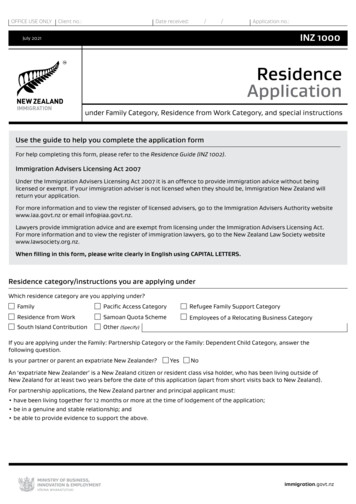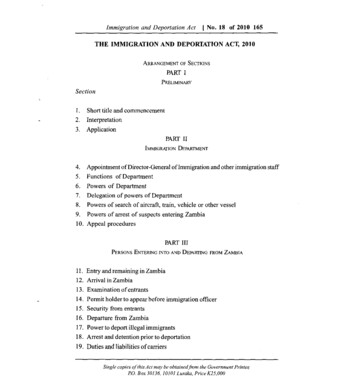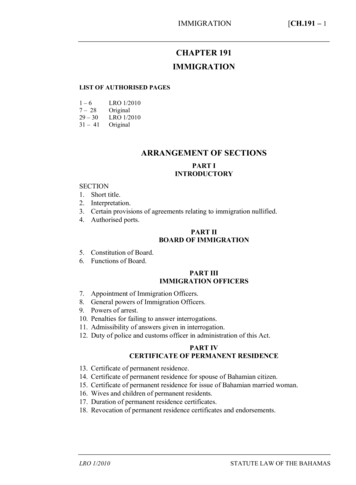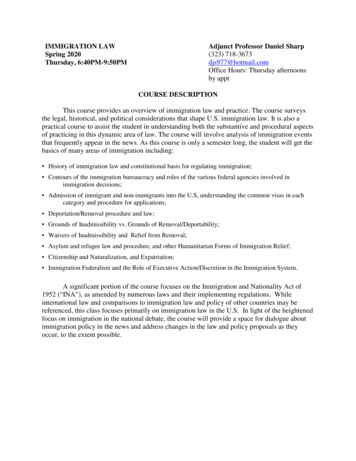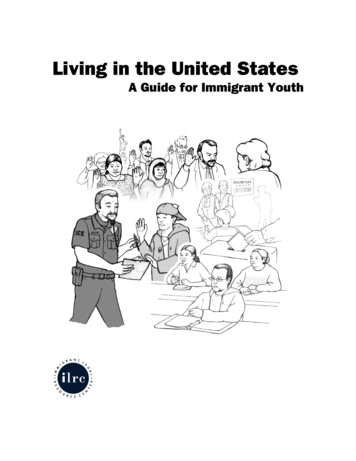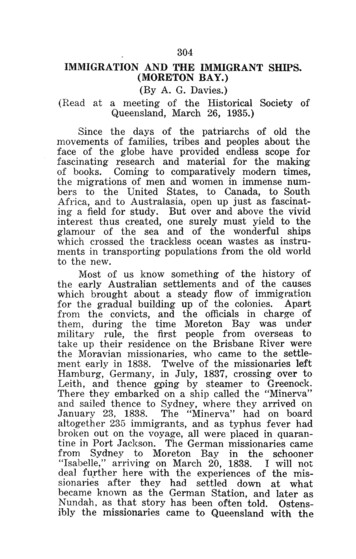
Transcription
304IMMIGRATION AND THE IMMIGRANT SHIPS.(MORETON BAY.)(By A. G. Davies.)(Read at a meeting of the Historical Society ofQueensland, March 26, 1935.)Since the days of the patriarchs of old themovements of families, tribes and peoples about theface of the globe have provided endless scope forfascinating research and material for the makingof books. Coming to comparatively modern times,the migrations of men and women in immense numbers to the United States, to Canada, to SouthAfrica, and to Australasia, open up just as fascinating a field for study. But over and above the vividinterest thus created, one surely must yield to theglamour of the sea and of the wonderful shipswhich crossed the trackless ocean wastes as instruments in transporting populations froni the old worldto the new.Most of us know something of the history ofthe early Australian settlements and of the causeswhich brought about a steady flow of immigrationfor the gradual building up of the colonies. Apartfrom the convicts, and the officials in charge ofthem, during the time Moreton Bay was undermilitary rule, the first people from overseas totake up their residence on the Brisbane River werethe Moravian missionaries, who came to the settlement early in 1838. Twelve of the missionaries leftHamburg, Germany, in July, 1837, crossing over toLeith, and thence gping by steamer to Greenock.There they embarked on a ship called the "Minerva"and sailed thence to Sydney, where they arrived onJanuary 23, 1838. The "Minerva" had on boardaltogether 235 immigrants, and as typhus fever hadbroken out on the voyage, all were placed in quarantine in Port Jackson. The German missionaries camefrom Sydney to Moreton Bay in the schooner"Isabelle," arriving on March 20, 1838. I will notdeal further here with the experiences of the missionaries after they had settled down at whatbecame known as the German Station, and later asNundah, as that story has been often told. Ostensibly the missionaries came to Queensland with the
305object of evangehsing the natives of the country,and they doubtless did good work in that direction. They certainly played a notable part in the settlement and development of the district in which theyoriginally settled, and ultimately in Southern Queensland generally.How Immigration Started.The development of Moreton Bay after it hadbecome a free settlement was much retarded in itsearly years by the lack of suitable labour. Manualworkers, shepherds, tradesmen and domestics weresorely needed bj the pastoralists and by those living within the town boundaries. This demand ledto the sending out of the first immigrant shipunder Government auspices—the"Artemisia"—towards the end of 1848, Some of the ships inwhich immigrants were brought to Australia aboutthat time were leaky, crazy old tubs which hadbeen previously used for conveying convicts and allsorts of undesirable cargoes. No such complaintcould be laid against the "Artemisia," because shewas an absolutely new ship, launched at Sunderlandtowards the end of 1847, and was making hermaiden voyage when she brought immigrants toMoreton Bay.The "Artemisia," a ship of 558 tons, was commanded by Captain John P, Ridley, and was chartered for her outward voyage by the Colonial Landand Emigration Commissioners. She embarked herpassengers at Plymouth, and left there on August15, with 210 migrants, Di. George K. Barton accompanying her as medical superintendent.Cooksland Settlement.In the "Illustrated London News" of August12, 1847, it was announced that the '"Artemisia"was about to leave "for the new settlement of theMoreton Bay district of New South Wales, otherwiseknown as Cooksland," It also was stated that theGovernment was giving free passages, includingfood, to New South Wales and South Australia, toagricultural labourers, shepherds, female domesticsand farm servants, and dairymaids; also to a fewblacksmiths, wheelwrights, carpenters, and othercountry mechanics," Mention was made of the
306fact that among those on the "Artemisia" wereseven boys and two girls from the Ragged Schools inWestminster, these being the first from these schoolsto leave England as colonists, though it was statedthat the intention was to send others subsequently.The "Artemisia" arrived off Cape Moreton onDecember 13, 1848, and landed her immigrants without delay. She left again on January 5, 1849, forSydney, and loaded wool there for London. Thethree ships which came out to Moreton Bay withimmigrants, under the auspices of the Rev. JohnDunmore Lang, followed very soon.Arrival of "Fortitude."The first of these was the "Fortitude," a shipof 608 tons, which arrived in Moreton Bay onJanuary 21, 1849, after a voyage lasting 128 days.Having had some infectious disease on the way out,the ship was placed in quarantine, and all theimmigrants landed on Moreton Island for the detention period. The ship had left Gravesend with 256passengers; but during the voyage there had beeneight deaths and four births. Dr. Challinor was themedical superintendent and, as cabin passengers therewere the Revd. Charles Stewart and Mrs. Stewart,Mrs. and Miss Challinor, Mr. W. Pettigrew andMaster George. After the immigrants had been released from quarantine they were brought up fromthe bay to Brisbane by the schooner "Susan," whichhad to make several trips for the. purpose.The Revd. Mr. Stewart, almost immediatelyafter his arrival in Brisbane, commenced to conductreligious services, the first of which was given inthe Court House, North Brisbane. Another of thenew arrivals, Mr. S. P. Welsby, started a boardingand day school at Ipswich. It is said that one ofthe immigrants brought out twenty tons of miscellaneous goods for sale as a speculative venture.Two of the lady passengers are said to have setup in business with hats and bonnets as their stockin trade. The "Fortitude" sailed from Moreton Bayon March 12, carrying 40 tons of local coal asballast, bound for Hongkong."Chaseley" and "Lima."The second of Dr. Lang's ships to visit Moreton
307Bay was the "Chaseley," of 515 tons, which arrivedon May 1, 1849, with 214 immigrants from London.The "Chaseley" was said to have been charteredby Dr. Lang on behalf of the Port Philip and ClarenceRiver Colonisation Coy, Under the command ofCaptain Charles F. Aldrich, she made the passageout in 120 days. Her cabin passengers includedMr. and Mrs. David M'Connel and servant, Mr. andMrs. Thomas Bowden and Miss Bowden, Dr. Hobbs,Mrs, and Miss Hobbs, Revd, Thomas Kingsford(Presbyterian), Messrs, William and Frank Aldrich,It is well known to students of the early historyof Moreton Bay that much dissatisfaction aroseamong the immigrants brought out in Dr. Lang'sships as a result of the refusal of the authoritiesto recognise the land orders issued to them.Some evidence of this is afforded by an advertisement which appeared in the Moreton Bay "Courier"of May 19, 1849, notifying a sale of goods broughtout by immigrants in the "Chaseley," "due to disappointment at not reeciving the land guaranteedto them by Dr. Lang."The "Chaseley" left Brisbane on July 15 forSydney, and was there chartered with quite a number of other ships to carry passengers to SanFrancisco, to which place people were flocking fromall parts of the world, owing to the discovery ofgold in California.The "Lima," the third of Dr. Lang's ships, wasmuch smaller than the others, being a barque ofonly 349 tons. She brought only 84 immigrants,among whom (according to the Sydney " ShippingGazette") were many who had paid their own passage money, and held land orders from Dr. Lang,and who also had brought agricultural labourerswith them. Dr. Wilkinson was the surgeon-superintendent, and among the cabin passengers wereRevd. Mr. Baker (chaplain), Mrs. Baker and family,Lieut. Collins, Mr. and Mrs. EUerby and child, Mrs.EUerby, Senr. Mr. and Mrs. Bailey and family, Mr.and Mrs. Lewis and family, Mr, and Mrs, Twine andfamily, Mr. and Mrs, Saunder and family, Mr. Hudson
308and family, Mr. Barlow and family, Mrs. Humby andson, Misses Fry (2). The "Lima" was commandedby Captain Adam Yule.Two ships arrived in Moreton Bay with convictssubsequent to the abolition of the convict settlement—the "Mountstuart Elphinstone" and the"Bangalore," in May, 1849, and April, 1850, respectively. These were mentioned in my paper on "TheGenesis of the Port," as also were the arrival ofthe " Nimrod" and the " Duke of Roxburgh," fromAmoy, with Chinese labourers, in 1848 and 1851,respectively.Deadly Typhus Fever.Tragic circumstances followed the arrival of thenext ship with settlers at Moreton Bay. The"Emigrant," a ship of 753 tons, left Plymouth onApril 17, 1850, with 276 immigrants for Queensland, Captain W. H. Kemp being in command. Thesurgeon-superintendent was Dr. George Mitchell, andCaptain Kemp's wife and child were on board.About a month after the ship left Plymouthtyphus fever made its appearance, and on her arrival in Moreton Bay, on August 8, there were 64cases on board. Fourteen deaths had occurred beforethe arrival of the vessel. Two others died in thenext two days, and when the ship went into quarantine at Dunwich she had on board 15 sick and 12who were convalescent.Dr. Mitchell feU a victim, dying on September15, on which Dr. Mallon, the health officer, tookcharge. He also was attacked, however, and Dr.D. K. Ballow, a Magistrate and Coroner of theMoreton Bay district, courageously assumed the responsibilities of surgeon-superintendent at the quarantine station. A few days later Dr. Ballow contracted the disease and died. Both Dr. Mitchell andDr. Ballow were buried in the cemetery at Dunwich.Before Separation.Between 1850 and 1859, the year in whichQueensland achieved her separation from New SouthWales, a number of ships were sent out with settlersfor Moreton Bay, under the auspices of the BritishGovernment. In 1852 several vessels came out to
309the settlement on the Brisbane River, the complement of immigrants carried ranging from 250 to 350.That however, was the year in which the goldrush to Victoria was at its height, and many shipswith between 900 and 1000 passengers each, werearriving in Port Phillip.The "Maria Somes," bringing 281 people, chieflyfrom Ireland, dropped anchor in Moreton Bay inJuly, 1852. The "Rajahgopaul," with 351 others,came in two months later.Those who made the voyage out in the "America"early in 1853, had an unfortunate experience and,on their arrival, told a sad story of a ship thatwas unseaworthy and very inadequately suppliedwith provisions. Even under the most favourableconditions, those who made the long voyage out toAustraUa in those days had inevitably to bearsome hardships and privations for which, however,most of them found ample compensations in thepleasures of sea travel—so long as the weatherwas fine. But when a large number of men, womenand children were crowded together in the 'tweendecks of a sailing ship, without proper regard forsanitation, and without reasonable supplies of foodand water, it can be imagined that their experiencewould be well-nigh unbearable.It is pleasing to reflect, however, that althoughthe case of the "America" did not stand out quitealone, similar instances in the Queensland immigrant service were exceedingly rare.Record Passage.As a rule the ships which came out to Australia in "the fifties" of last century were not remarkable for sneed, with the notable exceptions ofthe "Black Ball" and White Star liners, and thoseof one or two other companies. One ship whichvisited Moreton Bay in 1854, however, distinguishedherself by completing her outward voyage in 75days—an achievement which was only once equalled,and never surpassed, in the shipping annals of Brisbane. That was the "Genghis Khan," a ship of 1,306tons, which brought out 474 immigrants from Liverpool, putting up some remarkable sailing records onthe passage.
310Altogether 35 ships carried immigrants toMoreton Bay in the ten-year period referred to, andthe population of Queensland was augmented therebyby altogether about 10,000."First Real Boom."The first real boom in immigration commencedin 1861 and 1862, due chiefly to the successfulefforts of Mr. Henry Jordan, the attractions of theland order system, and to the greatly superior classof sailing vessel put into the service by Mackay,Baines & Coy., the managing owners of the famousBlack Ball line. This historic shipping combination owed its origin to the discovery of gold inVictoria in 1851 and the frantic rush of goldseekers from all parts of the world to Australia.All sorts and sizes of sailing vessels were used tobring fortune-hunters to Port Philip, which was thecentre of attraction—and in several instances fearless adventurers risked their lives in crossing thethousands of miles of ocean in fishing smacks andother frail craft.The opportunity was seized by James Baines, aLiverpool merchant, who purchased a few bigAmerican and Nova Scotian-built sailing ships andestablished the Black Ball line. He also had severalother clippers specially built for the trade by DonaldMcKay, of Boston, U.S.A., whose ships had gaineda reputation for supreme excellence in staunchnessand speed. The only one of these world-famousships which came into the Moreton Bay trade tenor eleven years later was the "Flying Cloud"—avessel whose consistent record as a "flier" stillremains one of the most outstanding in the historyof the clipper ships.Early Arrivals.A few ships other than those of the Black Ballline brought immigrants out to Queensland underGovernment auspices.Among these was the"Helenslee," which arrived on August 6, 1862, fromGlasgow, with 319 passengers. Among those whovoyaged out in her was the late Robert Philp(afterwards Sir Robert Philp), a Premier whoseTiame stands out conspicuously in the political history of his time.
311There were other ships belonging to otherowners which also made odd trips; but Mr. Jordancame to the conclusion that the interests of theState of Queensland would be best served by exclusively employing ships of the Black Ball Une. Hegave what seemed to be convincing reasons for thisin a report to the Colonial Secretary, dated January26, 1863.It appeared that at a time when other shippingfirms had been disinclined to enter wholeheartedlyinto the Queensland immigration scheme, and toaccept land orders in payment for the passagemoney, the Black Ball Coy. had shown a spirit ofenterprise, and readiness to co-operate, even to theextent of sharing in some measure the expenses ofthe Government's immigration campaign.Land Order System.Under the land order system the Governmentgave to each person who paid his or her full passagemoney, an order forland in Queensland tothe extent of 18 (18 acres), issuable on arrival;and a further order to the value of 12 (12 acres)issuable after two years' residence in the colony.In many instances the shipping company agreedto accept the 18 land order as a substitute for thepassage money, and those who arranged mattersthat way got what was virtually a free passage out.After a time, the issuing of the second landorder for 12, after two years' residence, wasdiscontinued.Nationality Regulations.A certain amount of controversy arose in theearly 60's as to the nationality of the immigrants—or rather the proportions of the people of theseveral British nationalities. The regulations laiddown that the nationalities year by year should consist of two-twelfths Scotch, three-twelfths Irish, andseven-twelfths English; but these proportions werenever strictly observed.In the early 60's very great distress prevailedin Ireland, due to a potato faminine, and othercauses, and the Queensland Immigration Society wasestablished in Brisbane, under the auspices of the
312Right Rev. Dr. Quinn, Roman Catholic Bishop ofBrisbane, with the object of assisting Irish immigrants to Queensland. This Society was responsiblefor sending out to Moreton Bay the ships "Erin-gobragh" and "Chatsworth," with immigrants fromCork, which arrived at their destination on Augustand September, 1862, respectively."Continuous Nightmare."The "Erin-go-bragh" had a voyage out which,from all the available records of the voyage, musthave been a continuous nightmare for all concerned.The vessel is said to have been formerly namedthe "Florida," and apparently her name was changedwith a complimentary intention, as a tribute to thefact that she was carrying Irish immigrants.One correspondent, writing to the newspapersof the day, said the "Erin-go-bragh" had previouslypassed under many aliases, and he described her asa crazy, leaky old tub. Be this as it may, withepidemic diseases of various kinds, the conditionson board during an unusually protracted voyage,must have been far from pleasant.About five months after her departure fromQueenstown, the "Erin-go-bragh" put into Hobart,all on board having suffered seriously from lack ofproper provisions. It was then discovered that thevessel's leaky condition was chiefly due to the factthat some evil-disposed person had bored severalholes with an auger in some of the bottom planking.These holes were plugged up before the ship leftHobart, and she finally reached Moreton Bay onJuly 31, 1862, or 174 days after she had saUedfrom Cork.Special Operatives.Other societies were formed with the idea ofpromoting the immigration of special classes ofworkers to the new colony, and among these werethe Bolton (Lancashire) Cotton Growing and Selling Coy., and the Lancashire and Queensland CottonGrowing Co-operative Society—and through the intervention of these a certain number of unemployedcotton operatives were sent out. During the two-
313year period, 1861-62, 10,497 British immigrants werelanded in Brisbane, made up as follows:—EngUsh,5,601; Scottish, 1,254; and Irish, 3,642.Colonists from Germany.About the end of 1860 a petition was presentedto the Government, bearing the signatures of 206German freehold settlers at Drayton and Toowoomba,asking that strong efforts be made to bring outfurther numbers of German colonists. As a directoutcome of this, Mr, J, C. Heussler was appointedto go to Germany as immigration agent for theQueensland Government, and he spent about twoyears in that country. The brig "Grasbrook," of241 tons, with 123 German settlers, and the ship"Caesar Godeffroy," of 428 tons, with 295 moreGerman colonists, arrived from Hamburg on thesame day—September 27, 1861.On a previous occasion six years earlier, onMarch 14, 1855, two small German barques hadarrived in Moreton Bay almost simultaneously withimmigrants. One of these, the "Merbz," brought out270, and the other, the "Aurora," 236. The latter,unfortunately, went ashore on Moreton Island andbecame a total wreck, but all the crew and passengerswere safely landed.The disaster was due to the fact that thecaptain had no chart and was under the impression that the south entrance was the only way intothe bay. On realising the hopelessness of his position he ran the vessel with square yards on tothe beach. The "Grasbrook," the "Johann Caesar,"the "Caesar Godeffroy," the "Iserbrook," and the"Helene" also brought out colonists from Germanyprior to 1860.First Black Ball Liners.The ship "WansfeU," of 770 tons, which arrivedin Moreton Bay on November 10, 1861, with 300immigrants, was announced as being the first BlackBall liner to come out under the company's agreement with the Queensland Government. But the ship"Montmorency," which was owned by the Black Ballline, had arrived on October 16 of the previous yearwith 310 new people. Both the "WansfeU" and the
314"Montmorency" were well-built and shapely vessels,launched from British North American shipyards in1853 and 1854, respectively. They both had beenbought by Mr. James Baines practicaUy off thestocks, and both had made voyages to Sydney andMelbourne with immigrants before their first visitto Queensland waters.The "Montmorency" was brought to MoretonBay in 1860 by Captain David M. Bridges who,however, died in Brisbane from filaria. The chiefofficer took the ship to Newcastle, where she loadedcoal for Hongkong.On her next outward voyage she droppedanchor under the lee of Moreton Island on April 8,1862, being then commanded by Captain J. T.Sowerby, She loaded wool in the bay for London,and on her homeward passage had the mostsensational experience of her career. She got amongicebergs in southern latitudes, and later encounteredgales of unparalleled ferocity, in which she wasbadly dismasted. While in this helpless conditionshe narrowly escaped being cast on the rocks nearthe dreaded Cape Horn.In April, 1863, under Captain MaxweU, the"Montmorency" left Liverpool with 400 immigrantsfor Hervey Bay (Maryborough), but she put intoMoreton Bay on July 17, and landed her passengersthere, instead of going on to Hervey Bay. Early in1866 the "Montmorency" took another lot of prospective settlers to Bowen, and the records showthat Captain Jas. Cooper, who was in charge, hada particularly trying time on the way out. It issaid that the captain and his oflflcers kept loadedrevolvers within reach day and night, and that itwas only by the adoption of such stern measuresthat a mutiny was avoided.From Bowen the"Montmorency" came to Moreton Bay and loaded awool cargo for London.In December of the same year she left Londonfor Napier, New Zealand, with immigrants, andarrived safely on March 24, 1867. All the passengerswere landed there but, on the following day, a firemysteriously broke out and the ship was burned tothe water's edge.
315The "Flying Cloud."The "Flying Cloud," to which passing referencehas already been made, was one of the most famousof the Boston-built clippers. She was added to theBlack Ball fleet in 1862; and at once put into theQueensland immigration service. Altogether the"Flying Cloud" made six voyages to Moreton Bayand one to Maryborough. She was sold in 1870,and four years later went ashore on the coast ofNew Brunswick, near St. John. She was floated offand towed into harbour. But the hand of Fate wasupon her, for while she was on a patent slip forrepairs, a fire broke out and she was so badly damaged that there was nothing for it but to breakher up.Famous Tea Clipper.Among the earliest of the Black Ball linersto come to Moreton Bay was the " Cairngorm"—avery famous ship in her day. She was built atAberdeen in 1853, expressly for the purpose ofwresting from the American tea clippers the supremacywhich had been theirs for a number of years. Thehighest hopes of the builders were realised, and the"Cairngorm" made a succession of passages betweenthe Chinese tea ports and London, which put all theperformances of the Americans into the shade. In1860, however, James Baines was able to purchasethe "Cairngorm" for the Black Ball line, and shewas put into the Australian trade under CaptainRobert Cairncross, a shipmaster who already hadmade a name for himself in Australian waters; andwho, in his later years, settled permanently inQueensland.The first two outward voyages of the " Cairngorm" under the Black Ball flag were made fromLondon to Sydney. In 1860 Captain Cairncross tookthe ship out in 88 days, a creditable performance.The "Cairngorm," however, demonstrated her sailing qualities better on the return passage to London with wool, which was accomplished in 72 days,and on her next outward trip she dropped anchorin Sydney Harbour ,77 days after leaving the Thames.In the following year Captain Cairncross wastransferred to the command of the "Queen of the
316Colonies," a larger ship engaged in the conveyanceof immigrants to Moreton Bay. The "Cairngorm"came out to Moreton Bay a little later in the sameyear, under the command of Captain JamesMathew Banks, bringing 353 immigrants who hadembarked partly in Liverpool and partly in Glasgow.In September, 1864, Captain Banks came out toBrisbane as a passenger in the ship "Queen of theColonies," to take up the position of ship's husbandin Brisbane for the Black Ball line, which then hadquite a number of ships regularly engaged in the trade.For many years Captain Banks was well known as amarine surveyor, both in Brisbane and Sydney.Thirty years or so. ago I was on terms of personalfriendship with him—a capable, intrepid seaman andone of the kindliest of men. His sons, under thename and style of Banks Brothers, have been longidentified with the Torres Straits pilot service.Venus Shoal.The Banks family had another association withthe early history of Moreton Bay, On November23, 1855, the brig "Venus," of 137 tons, commandedby Captain Thomas Mathew Banks, was cominginto Moreton Bay for provisions and making use ofFreeman's Channel, the northern entrance, instead ofthe usual ship's channel. She struck on a bank andbecame a total wreck, though the oflftcers and crewwere able to land safely on Moreton Island. Thename Venus Shoal was given to the spot whereshe had struck and appears on the charts to-day.Captain T. M. Banks was a brother of CaptainJ. M. Banks."Young Australia."One of the immigrant ships which will alwaysbe well remembered in the annals of Moreton Bayis the "Young Australia." After her voyages outward, by means of which she added nearly 3,000 newsettlers to the population of the State, the good shiptook the ground on Moreton Island and refused tobudge therefrom. That furnished an added reasonwhy her memory should endure as part of Queensland's historical fabric. In respect to speed the"Young Australia" was something of super quality.As the "Red Rover" the ship had been launched
317from the shipyard of Femald and Pettigrew, Portsmouth, New Hampshire, U.S.A., in 1852; and shemade a great name for herself by the records putup between New York and San Francisco. In 1859she carried a shipment of Chinese coolies fromHong Kong to Sydney. Soon after, she was boughtby the Black BaU line and her name changed to"Young Australia," Under that name she made avoyage from Liverpool to Melbourne in 1861; butafter that Moreton Bay was invariably her Australian destination. On August 9, 1862, she arrivedin the bay after a smart passage of 84 days fromPlymouth, having 277 immigrants on board. Shewas commanded by Captain John Duthie Phillips,.a master mariner hailing from Aberdeen, who, inspite of his youth, had already won a high reputation as a seaman and a man. He brought t h e"Young Australia" twice out to Moreton Bay. Ihave in my possession the originals of addressesof appreciation presented to him by passengerswho came out with him in 1862 and 1863. Amongthose who signed those testimonials are severalnames of individuals who played a prominent partin the development of Queensland.Captain Charles Grey was chief officer in 1862and 1863, and he then had command for four roundvoyages. Captain Daniel R. Bolt was in chargeof the "Young Australia" in 1868 and 1869, andCaptain James Cooper in the two following years.Captain J. D, S, PhiUips, a son of Captain J. D.PhiUips, comes to Brisbane twice monthly as coastalpilot for Bums, Philp & Coy.'s Singapore steamers.Captain J, C. Grey, who holds the responsible position of marine superintendent to the Marine Underwriters' Association of Queensland, is a son of Captain Charles Grey.Wrecked on Moreton Island.I need only make brief reference to the end ofthe "Young AustraUa," the story of which has oftenbeen told. The disaster occurred just after the"Young Australia" had weighed anchor in MoretonBay, outward bound for London, on May 31, 1872.It was caused by the wind falling suddenly to a
318dead calm, with a heavy easterly swell, and a strongsoutherly current setting the ship towards the rocks.The vessel struck broadside on and remainedstationary. With the flood tide her position becameworse. Finally, she got firmly wedged in a V-shapedhoUow between rocks, and many months passedbefore she actually broke up. Seldom has a wreckoccurred with less sensationalism, for not only wasthere no loss of life, but all personal property wassaved, and the entire cargo of wool was salvaged.The figure-head of the "Young Australia" wasmounted and exhibited in the gardens of Newsteadalongside a battery of guns, where it remained formany years. What became of it?Captain James Cooper, who was fully exoneratedfrom blame for the loss of the ship, had previouslycommanded the clipper ships " Montmorency" and"Royal Dane," in the Queensland immigration service. He finally settled in Brisbane, He was fora time in the Pacific Island trade; but afterwardswas for some years in the employ of the MarineDepartment,I believe he had three or fourdaughters, who took up the nursing profession. Oneof them, the widow of Dr. C. S. Hawkes, still livesin Brisbane. Another is Mrs. Arthur Aplin, ofMaleny, North Coast.Ships in the Bay.Perhaps I may not inappropriately at this stagequote from an article which appeared in the"Courier" a few years ago, written by someone familiar with the conditions prevailing in Moreton Bayin the late 60's and the early 70's. At that period,he says, the big ships of the Black Ball line, owingto their deep draught, were unable to enter theriver, and had to anchor in what was known as theBrisbane roads."The anchorage, a very safe one, was in thevicinity of the present Pile Light. (That, of course,is what is now known as the "old" Pile Light, andwhich has been replaced by a more modem structure.) Here, the writer continues, the ships wereloaded and unloaded with the aid of lighters— largebarges which would be towed up and down from
319J. and G. Harris', Short Street, Wharf, by theirsteamer "Emma," whose Captain, Peter Rice, wasthe beloved of the waterside workers.""The process of loading and unloading by thismeans was naturally pretty slow work, as duringheavy weather, it was difficult for the lighters to getalongside the ships. Sometimes a ship would bein port for more than a month before she wouldbe able to get away; but that was accepted as allpart of the fun and no one objected very much. Thesailors got more shore leave and the captains wereroyally entertained at Newstead by that queen ofhostesses,
Having had some infectious disease on the way out, the ship wa places ind quarantine, and all the immigrants landed on Moreton Island for the deten tion period. The ship had left Gravesend with 256 passengers; but during the voyage there had been eight deaths and four births. Dr. Challinor was the


